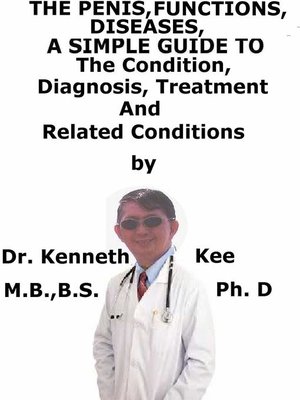The Penis, Function, Diseases, a Simple Guide to the Condition, Diagnosis, Treatment and Related Conditions
ebook
By Kenneth Kee

Sign up to save your library
With an OverDrive account, you can save your favorite libraries for at-a-glance information about availability. Find out more about OverDrive accounts.
Find this title in Libby, the library reading app by OverDrive.



Search for a digital library with this title
Title found at these libraries:
| Loading... |
This book describes Penis, Function, Diseases, Diagnosis and Treatment and Related Diseases
The penis consists of a short cylindrical body, pendulous in the flaccid state, covered by skin and attached by its root to the anterior part of the perineum.
The penis is made up of 3 columns of body tissues with:
1. Two cavernous tissue bodies (right and left corpora cavernosa) joined together forming the dorsal aspect and grooved ventrally by:
2. The third cavernous body the corpus spongiosum.
The enlarged and bulbous-shaped end of the corpus spongiosum forms the glans penis which is covered by the foreskin or prepuce that in adults can retract to expose the glans.
The region on the underside of the penis where the foreskin is attached is called the frenulum.
The rounded base of the glans is termed the corona.
The rim of the cap the corona glandis protrudes from the neck of the penis and at the apex of the glans is the vertical slit of the external urethral orifice.
Near the symphysis the corpora cavernosa deviate tapering as the crura to bind itself to the conjoint ischiopubic rami below the urogenital diaphragm and covered by the ischiocavernous muscles.
The corpus spongiosum is covered by the bulbospongiosus muscles and become connected to the urogenital diaphragm in the midline terminating just in front of the perineal body in the expanded bulb of the penis where the urethra enters from above.
The urethra which is at the end of the urinary tract traverses the corpus spongiosum and its opening called the meatus lies on the tip of the glans penis.
Sperm are formed in the testes and stored in the attached epididymis.
During ejaculation, sperm are forced up the vas deferens, two ducts that pass over and behind the bladder.
Fluids are provided by the seminal vesicles and the vas deferens becomes the ejaculatory ducts, which join the urethra inside the prostate gland.
The prostate and the bulbourethral glands provide further secretions, and the semen is expelled through the penis.
Functions of the Penis:
The penis is described as a man's sex organ and its urinary sprout.
The human penis is an external sexual organ of the males with an amazing structural design.
It is a reproductive, intromittent organ that also serves as the urinal duct.
The penis is a vascular structure of erectile tissue about 4 to 6 inches long containing arterioles and blood storage spaces.
Erection
An erection is the hardening and rising of the penis, which happens during sexual arousal
The primary physiological mechanism that causes erection is the autonomic dilation of arteries supplying blood to the penis, which permits more blood to fill the three spongy erectile tissue chambers in the penis, making it lengthen and stiffen.
Erection makes sexual intercourse easier.
Urination
In males the expulsion of urine from the body is also done through the male penis.
The main types of male sexual dysfunction are:
1. Erectile dysfunction (difficulty getting/keeping an erection)
This disorder is normally regarded an age-related problem.
In older men loss of function may happen as testosterone levels decrease, the circulation becomes affected by heart disease or smoking, or a band of midlife fat forms around the waistline.
There are now oral medicines available to treat erectile dysfunction (phosphodiesterase inhibitors e.g. Viagra, Cialis, and Levitra)
2. Ejaculatory Dysfunction
a. Premature ejaculation (reaching orgasm too quickly)
b. Delayed or inhibited ejaculation (reaching orgasm too slowly or not at all)
c. Retrograde or no ejaculation (dry...






